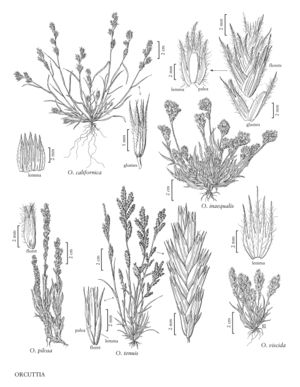Difference between revisions of "Orcuttia pilosa"
imported>Volume Importer |
imported>Volume Importer |
||
| Line 41: | Line 41: | ||
|publication year= | |publication year= | ||
|special status=Endemic | |special status=Endemic | ||
| − | |source xml=https://bitbucket.org/aafc-mbb/fna-data-curation/src/ | + | |source xml=https://bitbucket.org/aafc-mbb/fna-data-curation/src/200273ad09963decb8fc72550212de541d86569d/coarse_grained_fna_xml/V25/V25_945.xml |
|subfamily=Poaceae subfam. Chloridoideae | |subfamily=Poaceae subfam. Chloridoideae | ||
|tribe=Poaceae tribe Orcuttieae | |tribe=Poaceae tribe Orcuttieae | ||
Latest revision as of 18:59, 11 May 2021
Plants cespitose, hairy, usually densely so. Culms 5-20(35) cm tall, 1-2 mm thick, simple or branching at the lower nodes, erect or decumbent, sometimes geniculate. Leaves with a faint "collar" line usually evident when dry; blades 4-6 cm long, 3-5(8) mm wide. Spikes to 10 cm; lower internodes 5-15 mm; upper internodes 1.5-3 mm. Spikelets with 10-40 florets. Glumes about 3 mm, irregularly 3-toothed; lemmas 4-5 mm, teeth about equal and 1/3–1/2 as long as the lemmas, acute or awn-tipped; anthers 2.5-3 mm. Caryopses about 2 mm, elliptical; embryos 3/4 or more as long as the caryopses. 2n = 30.
Discussion
Orcuttia pilosa grows at elevations below 150 m in Madera, Merced, Stanislaus, and Tehama counties, California. It is listed as an endangered species by the U.S. Fish and Wildlife Service.
Selected References
None.
